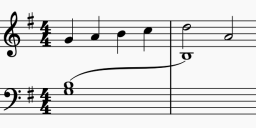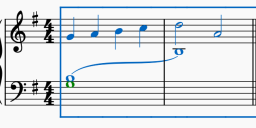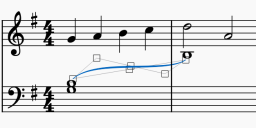What is this notation?
-
Currently I help our organist with music for Vespers, despite not being an organist myself. (I know the rubrics and know my way around a computer, by the grace of God, I guess.) Next month we are doing Vespers for the feast of the Immaculate Heart of Mary from the pre-conciliar antiphonale (Vespers of Our Lady, proper Magnificat antiphon). The psalm chosen for this question is not from those Vespers, but you can see why the music used is not written in a helpful way so as to require fixing it, even though it's the complete office of Vespers up unti 1934 (it's Potiron, in case you're wondering).
Anyway, the circled bits: what is that, and can I reproduce it in Musescore? It appears often enough in the scores that it seems important to not omit. (I'll ask over on that forum if necessary…)
And never mind playing from imperfect written accompaniment… We just need to keep Vespers alive; we get 30 or so people in normal months, which is excellent.Thanked by 1tomjaw -
Right, so the problem is that you can’t tie across staves without moving the note to one or the other staff unless I’m missing something. In other words, the tie can only go across, it can’t twist upwards. (I’m trying to only change things that ultimately make the psalm more readable, not create a totally different thing…)
-
@MatthewRoth Enter the tied note in the bottom staff, select and press Ctrl+Shift+↑. Then tweak the control points of the tie to get the curves right.

 Capture1.PNG704 x 307 - 21K
Capture1.PNG704 x 307 - 21K
 Capture2.PNG720 x 333 - 24K
Capture2.PNG720 x 333 - 24K
 Capture3.png718 x 313 - 27K
Capture3.png718 x 313 - 27K -
Matthew, I'm confused why you say that the music is not written in a helpful way. As an organist myself, this is an eminently readable example, and it is quite common to see harmonized chant written this way. What about it is the problem? Is it that this isn't what the singers need? If that's the case, I'd agree with you. But for an organist, this should be just fine.
-
I am zero organist, but an experienced pianist. For me, that notation is weird: in all the quoted cases it would make more sense to leave the tied note in the bass staff. But it isn't. What does it convey to an organist?
-
Organ is binary: on or off, ergo, tying what was the tenor voice to what becomes the alto voice (to maintain 4 part texture) is an indication not to lift the finger but sustain the C.
In the case of the last two measures, you notice that the D in the bass and the D in the alto are both sustained while S/T change. It is a bit finicky, but it's not at all uncommon. -
Serviam, the flex and any changes (i.e. extra syllables) to the mediant are at the end of the music, and changes to the final also follow. If you do Sunday Vespers weekly, you’ll figure it out, but it gets more challenging when the rubrics call for something else or if special occasions come up. Not all psalms have a flex, and if the organist accounts for it in the French parochial style, then knowing that it’s coming in this psalm is better than having to frantically look down the line. (Obviously playing from square notes is ideal. However…)
Giulio Bas’s music is also weird in its way — he does not always provide the Magnificat music after the antiphon, and the key sometimes changes if you do go back to the collected simple tones. He never gives the solemn tone unlike Potiron.
Gerard, huzzah, I think that should do it. Also, it is obvious that I never had to learn treble clef below the staff — I learned bass clef for trombone, then square notes with solfège, then have sung tenor mostly with treble clef (but with solfège instead of notes or only notes on the staff — a few pieces were in bass clef). -
Considering chant formulæ are… formulaic, I’m not sure exactly what the problem is, based on your comment. In theory, you aren’t sight reading this live during liturgy, and if you are, and are then left frantically searching in the heat of the moment, that’s your own mistake, for which immediate atonement will be evident.Serviam, the flex and any changes (i.e. extra syllables) to the mediant are at the end of the music, and changes to the final also follow. If you do Sunday Vespers weekly, you’ll figure it out, but it gets more challenging when the rubrics call for something else or if special occasions come up. Not all psalms have a flex, and if the organist accounts for it in the French parochial style, then knowing that it’s coming in this psalm is better than having to frantically look down the line. (Obviously playing from square notes is ideal. However…)
Welcome to the MusicaSacra Forum!
To participate in the discussions on Catholic church music, sign in or register as a forum member, The forum is a project of the Church Music Association of America.
Categories
- All Discussions21,158
- General Music Discussion8,236
- Job Openings204
- Management of Music Programs850
- Choral Matters533
- Church Documents and Rubrics526
- CMAA Notes304
- Events720
- For Newcomers: Read First26
- Sacred Polyphony547
- Hymnody872
- Gregorian Chant: General2,702
- ↳ Graduale Romanum and Liber Usualis368
- ↳ Graduale Simplex60
- ↳ Semiology63
- Vernacular Plainsong696
- Anglican Use and Anglican Chant68
- Organ, Other Instruments and Repertoire435
- New Composition/Works in Progress1,295
- Recordings234
- Music for Hispanic Ministry159
- Music Education: Children211
- Music Education: General222
- News Items245
- Positions Wanted2
- General Discussion: Catholicism740
- Amusements177
- General Discussion1,035
- Opinions119
